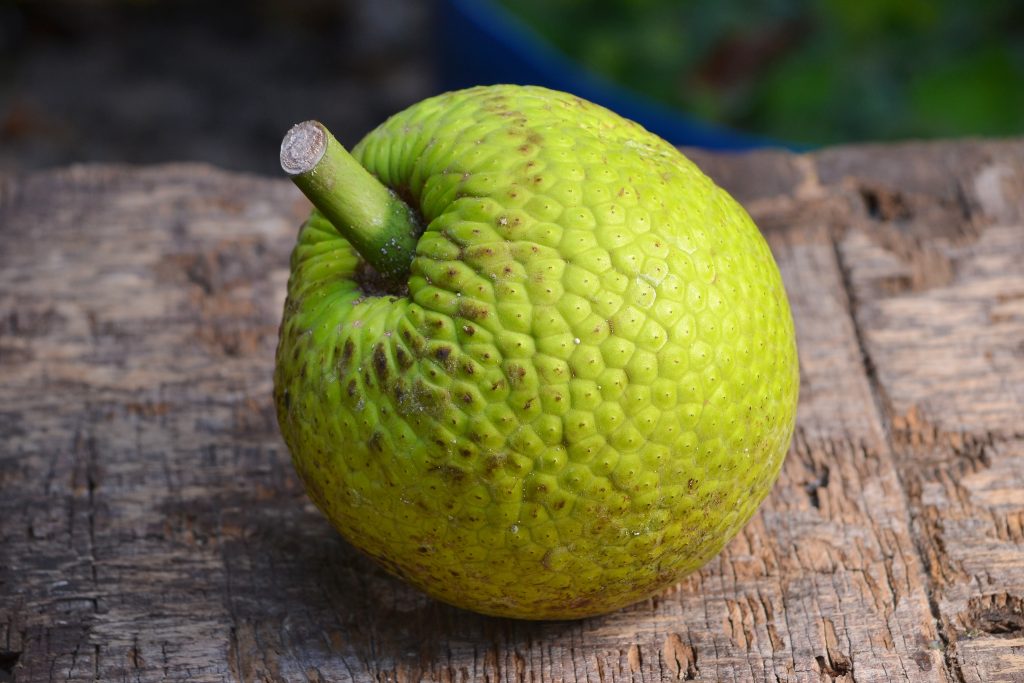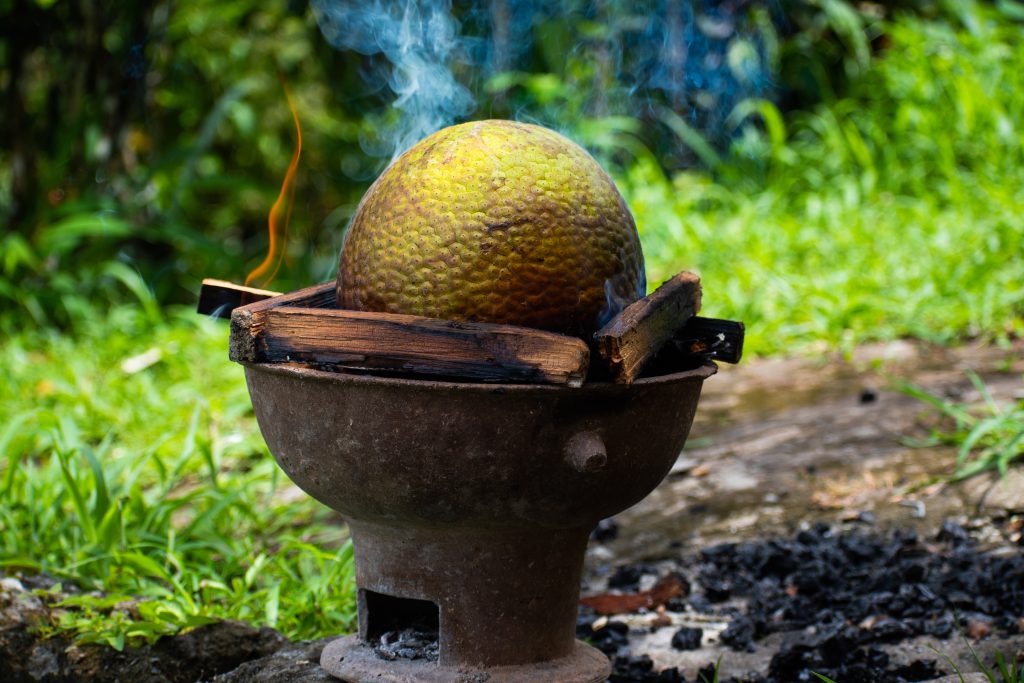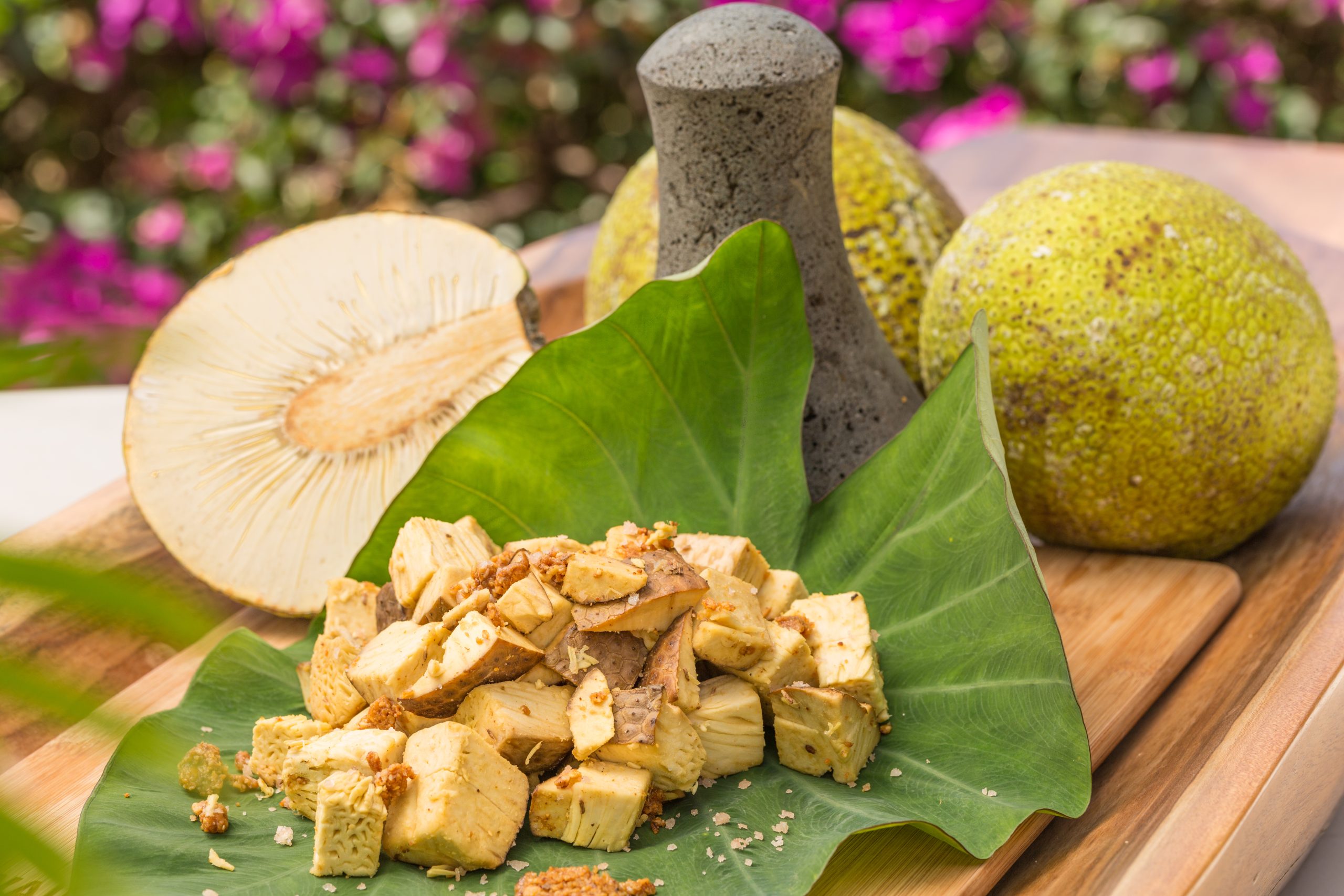Breadfruit is a starchy fruit that originated in the South Pacific but has become a staple in Caribbean cuisine. It is a member of the mulberry family and is known for its versatile nature, as it can be cooked in various ways and used in both sweet and savory dishes.
Table of Contents
What is a Breadfruit?
Breadfruit (Artocarpus altilis) is a tropical fruit from the mulberry family (Moraceae). It is also known as ulu in Hawaiian, and other names include rimas, sukun, and breadnut.
Breadfruit is native to the Pacific Islands and is a staple food in many tropical regions, including the Caribbean, Central America, Southeast Asia, and Polynesia. The breadfruit tree is large, reaching up to 80 feet (24 meters) in height, and can produce hundreds of fruits annually. The latex extracted from the tree also has a lot of uses, including caulking material for canoes and glue.
The fruit of the breadfruit tree is large, round, and can weigh up to 10 pounds (4.5 kilograms). Its outer skin is green and prickly, with starchy, creamy-white flesh inside. The fruit’s external appearance resembles jackfruit.
When cooked, the flesh has a texture similar to bread or potatoes, hence its name. The fruit’s seeds are also edible when roasted or boiled.
Breadfruit has a mild, slightly sweet flavor, often compared to a combination of potato, bread, and artichoke. It is a versatile fruit that can be boiled, roasted, grilled, or fried and used in savory and sweet dishes. In many cultures, breadfruit is considered a nutritious and sustainable food source, as it is high in fiber, vitamins, and minerals.
Why is it Called breadfruit?
Breadfruit got its name because of its starchy texture and flavor, similar to freshly baked bread. When the fruit is cooked, it becomes soft and tender, and its texture and taste resemble that of bread. The fruit’s texture and flavor have made it a staple food in many cultures worldwide, particularly in Pacific Island nations.
Captain James Cook, who sailed to the South Pacific in the 18th century, called it “breadfruit” because it resembled bread. The name caught on, and today the fruit is known as breadfruit in many parts of the world.
The History of Breadfruit
Breadfruit is more than just a tasty fruit – it carries a rich history of adventure, rebellion, and cross-cultural exchange that spans thousands of years.
Breadfruit was first discovered in the South Pacific, known as “ulu” in the Polynesian language. The fruit was an important food source for indigenous Polynesian people, who roasted it over an open fire, baked it in an earth oven, or steamed it in a pit.
When Polynesian explorers set their sights on Hawaii, they brought breadfruit seeds, planting vast food crops that could sustain whole communities, assuring food security.
But the story doesn’t end there. It wasn’t just the indigenous peoples of the Pacific who recognized the value of breadfruit, but also Europeans. In the late 18th century, British explorers recognized the potential of this fruit as an inexpensive, highly nutritious food source for enslaved people in the Caribbean. Captain William Bligh, commander of the HMS Bounty, and his crew were tasked with transporting over a thousand Breadfruit trees from Tahiti to the Caribbean.
Breadfruit eventually took root in the Caribbean, and today it remains a staple food in tropical and subtropical regions worldwide. Institutions like the National Tropical Botanical Garden in Hawaii and The Breadfruit Institute (which studies hundred of varieties of breadfruit) are working tirelessly to preserve and research breadfruit, ensuring its story continues to inspire.
Lastly, you might’ve heard about this fruit in a song called “Roast or Fry (Breadfruit),” written by Jamaican musician and artist named Chi Ching Ching.
What Does a Breadfruit Taste Like?
When raw and unripe, breadfruit has a firm, starchy texture and a mild, slightly sweet taste. Some people compare the taste to that of a potato or yam. As the fruit ripens, it becomes softer and sweeter, with a flavor akin to a ripe banana.
Breadfruit CAN’T be eaten raw! One must cook fresh fruit before consuming breadfruit as it contains a naturally-occurring latex.
When breadfruit is cooked, its texture is soft and creamy, with a flavor similar to a baked potato or roasted squash. It can be boiled, fried, baked, or roasted and used in stews, curries, and other savory dishes.
How to Tell When Breadfruit is Ripe
Knowing when it is ripe is essential to ensure it is flavorful and ready to eat. Here are some visual characteristics of ripe breadfruit:
| Firmness | A ripe breadfruit will give slightly when squeezed but should not be mushy or overly soft. It may be overripe and not as flavorful if it feels too soft. |
| Scent | A ripe breadfruit will have a sweet, slightly fruity aroma. It may be past its prime if it has a strong, unpleasant odor. |
| Smoothness/Roughness | The skin of ripe breadfruit will be smooth and free of blemishes or bruises. If the skin is rough or has visible damage, it may be damaged or not fully mature. |
| Color | The skin of ripe breadfruit will be yellow or greenish-yellow and may have some brown spots or discolorations. If it is still mostly green, it may not be fully ripe. |
Breadfruit vs. Jackfruit


Breadfruit and jackfruit are tropical fruits that are often compared due to their similar appearance and texture.
Similarities
- Both fruits are large, spiky, and green on the outside.
- They are commonly found in tropical regions, including Southeast Asia and the Caribbean.
- They are both rich in carbohydrates and fiber.
Differences
- Breadfruit is a starchy fruit with a mild, nutty flavor, while jackfruit has a sweet, fruity flavor that some describe as similar to a combination of pineapple and banana.
- Breadfruit is typically cooked and used as a potato substitute in savory dishes. In contrast, jackfruit is often used as a meat substitute in vegetarian and vegan dishes due to its meaty texture.
- Breadfruit is harvested when it is fully mature and has a hard, green skin, while jackfruit can be harvested at various stages of ripeness and has a softer, more pliable skin.
Can I Eat Raw Breadfruit?
No, it is not safe to eat raw breadfruit. Breadfruit contains naturally occurring latex that can cause an adverse reaction in some people when raw or undercooked. This latex contains proteolytic enzymes that can irritate the throat, cause digestive discomfort, and even lead to anaphylaxis in individuals with latex allergies.
Cooking the breadfruit denatures the latex and renders it safe for consumption. Boiling, baking, roasting, or grilling are common methods to cook breadfruit. Once cooked, the flesh of the breadfruit becomes tender and starchy, with a mild and nutty flavor that makes it a popular ingredient in many dishes.
Cooking with Breadfruit
To prepare breadfruit:
- Start by washing it with water and a brush to remove any dirt or debris on the skin.
- Cut off the stem and the base of the fruit using a sharp knife.
- Cut the fruit in half and remove the core, which is the spongy white part at the center of the fruit.
- Cut the fruit into smaller pieces or slices as desired.
- Remove the skin using a knife or peeler.
Breadfruit can be cooked in various ways, including boiling, frying, roasting, or grilling. In many traditional cuisines, breadfruit is a starchy ingredient in dishes such as stews, curries, soups, and porridge. It can also be used as a substitute for potatoes, yams, or plantains.
Breadfruit is a staple food in many tropical regions, including the Caribbean, Pacific Islands, Jamaica, and Southeast Asia. Breadfruit is also a popular ingredient in vegan and vegetarian cooking.

Here are some delicious recipes featuring breadfruit:
Spicy Breadfruit Fries: Why settle for regular fries when you can add some heat and tropical flair to your snack game?
Breadfruit with Coconut Milk: This recipe is perfect for those who want to savor the natural flavor of the breadfruit without overwhelming it with too many spices.
Breadfruit Nigerian Ukwa: 2 ways: Look what we have here! Nigerian Ukwa in not just one, but TWO ways! If you’re tired of the same old bland meals, get ready to shake things up with this exotic fruit.
Breadfruit Pie: This pie is not your average dessert; it’s a bold fusion of flavors that will leave you wanting more.
Breadfruit Tacos: Try this interesting combination for a unique twist on taco night. It’s like a mash-up of Mexican and Caribbean flavors; trust us, it works.
Sri Lankan Breadfruit Curry: This recipe takes the breadfruit to new heights by infusing it with the exotic and fragrant flavors of Sri Lankan cuisine. It involved cooking breadfruit in a flavorful pot mixed with curry leaves, fenugreek, minced garlic, turmeric, chili powder, pepper powder, onions, and salt.
How to Store Breadfruit
Whole, unripe breadfruit can be stored at room temperature for 7-10 days. Place the fruit in a cool, dry place away from direct sunlight. Once ripe, it should be consumed within 1-2 days, as it will start to spoil.
To store ripe breadfruit, keep it in the refrigerator in a perforated plastic bag or container for up to a week. This slows down the ripening process and preserves the fruit. Before consuming, allow it to sit at room temperature for a few hours.
Freezing breadfruit is an effective way to store it for a more extended period (up to 12 months).
Drying breadfruit is a traditional method of preserving the fruit for up to 12 months or longer. To do this, peel and thinly slice the fruit. You can sun-dry the slices or use a food dehydrator until they are brittle and have a low moisture content. Once dried, store the breadfruit in airtight containers in a cool, dark place.
Nutritional Benefits of Breadfruit
Breadfruit is a starchy fruit with numerous health benefits due to its various nutrients and plant compounds. It offers a rich source of complex carbohydrates while maintaining low fat and being free of cholesterol and gluten. Its glycemic index is more favorable than white potatoes, white rice, and white bread, meaning it doesn’t cause a rapid spike in blood sugar levels.
The prenylated phenolic compounds found in breadfruit provide anti-inflammatory properties that can help alleviate joint and muscle pain. Its high fiber content makes it an excellent option for gut health.
Breadfruit flour is an excellent gluten-free alternative easily digestible and contains beneficial bioactive compounds. Breadfruit extracts have antibacterial effects, which can help prevent bacterial infections caused by Streptococcus mutans and Pseudomonas aeruginosa.
Breadfruit is packed with beneficial amino acids (like vitamins A and C and omega-3 fatty acids) that help fight against free radicals, help with infertility, and aid brain cells.
Moreover, breadfruit can potentially prevent type 2 diabetes thanks to its low glycemic index, and its carotenoid content (vitamin A) can help support eye health.
Although traditional medicine has used breadfruit pulp as a liver tonic and treatment for liver cirrhosis and hypertension, there is little scientific evidence to support that eating breadfruit would have these benefits.
Lastly, breadfruit is also a calcium, potassium, and vitamin C source.
Where to Purchase Breadfruit
Breadfruit is a tropical fruit that can be found in some specialty stores and farmers’ markets in areas where it is grown. However, it may only be widely available in some regions with warmer climates.
The best time to find fresh breadfruit is during its peak season, which varies depending on the location. Generally, the fruit is harvested between August and October, but some regions may have different harvest times.
If you are in the United States, you may be able to find breadfruit in specialty stores that cater to Caribbean, African, or Pacific Islander communities. Some farmers’ markets may also carry the fruit during its peak season.
Online retailers like Amazon may also offer breadfruit products, such as flour, chips, and canned breadfruit. These products can be convenient if fresh breadfruit is unavailable in your area.

